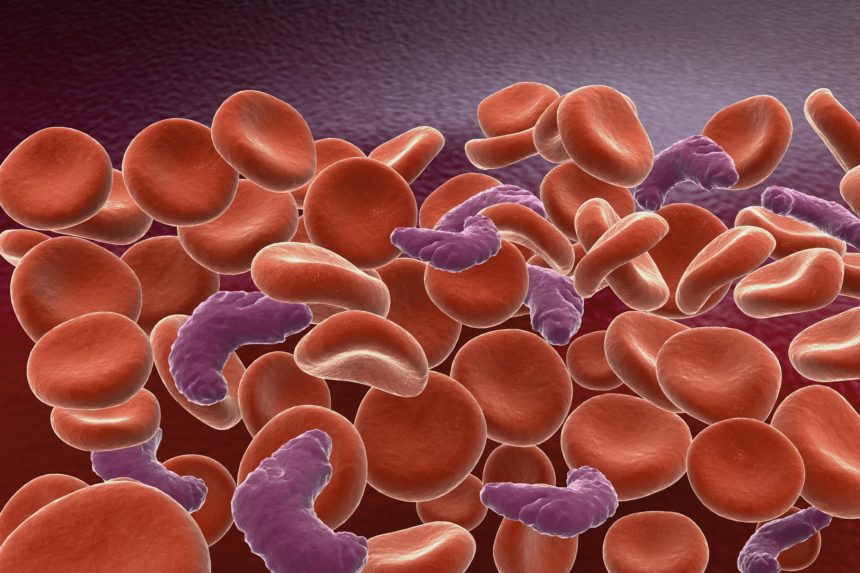Sickle cell Disease is a blood disorder that a child is born with. It’s passed down through a parent’s genes. Sickle cell disease is an inherited disease of the red blood cells in which the body’s supply of healthy red blood cells is insufficient to transport oxygen throughout the body.
Flexible, spherical red blood cells normally flow freely through the blood channels. Red blood cells in sickle cell disease are shaped like crescents or crescent moons. These tough, sticky cells can become trapped in small blood veins, which cut off the flow of blood and oxygen to areas of the body.
On the other hand, Treatments can help reduce discomfort and avoid disease-related concerns.
Symptoms of Sickle Cell Anemia
Symptoms of sickle cell disease usually occur around five months of age. Symptoms may vary from one individual to the next and develop with time.
1. Anemia: Sickle cells usually break and die, leaving you with an insufficient number of red blood cells. Red blood cells last around 120 days before needing to be replaced. However, sickle cells normally die in 10 to 20 days, leaving a red blood cell deficiency (Anemia).
Your body can’t obtain enough oxygen if there aren’t enough red blood cells, resulting in weariness.
2. Painful episodes: Agonal attacks, or periodic episodes of pain, are common symptoms of sickle cell disease. Pain occurs when sickle-shaped red blood cells impede blood flow to your chest, abdomen, and joints through small blood channels. Bone pain is also a possibility. Discomfort can vary in intensity and persist from a few hours to several weeks. Some only suffer a few pain crises while others suffer from more pain crises per year. A hospital stay is needed in a serious pain crisis.
Chronic pain affects some teenagers and adults with Anemia of sickle, which can be caused by bone and joint degeneration, ulcers, and other factors.
3. Hands and feet swelling: The sickle-shaped red blood cells restrict blood flow to the hands and feet, causing swelling.
4. Recurrent Infections: Your spleen can be damaged by sickle cells, which makes you more susceptible to infections. Vaccinations and antibiotics are regularly given to babies and children with sickle cell Anemia to prevent potentially threatening diseases from life such as pneumonia.
5. Delay in puberty or development: Red blood cells transport nutrients and oxygen throughout your body, allowing you to grow well. In infants and children, a lack of healthy red blood cells can limit growth and delay puberty.
6. Problems with vision: The small blood vessels that supply your eyes might get clogged with sickle cells. This can cause vision issues by damaging the retina, which is the part of the eye that interprets visual pictures.
When should you see doctor?
The most prominent way to diagnose sickle cell Disease in children is through newborn screening programs. If your child is having the following symptoms, contact your doctor or seek emergency medical attention straight away:
- People with sickle cell disease are more likely to get sick, and fever is often the first symptom of infection.
- Severe discomfort in the belly, chest, bones, or joints that is unrelated to anything else.
- Swelling of the hands and feet
- Swelling in the abdomen, particularly if the abdomen is painful to the touch.
- There is a pale color in the nail beds.
- The skin or the whites of the eyes have a yellow tint.
- Symptoms or signs of a stroke or you develop one-sided paralysis or weakness in the face, arms, or legs; confusion; difficulty walking or talking; rapid vision changes or unexplained numbness; or a strong headache.
Causes of Sickle Cell Anemia
Sickle cell Disease is caused by a mutation in the gene that causes your body to produce the iron-rich protein that makes blood red and helps red blood cells transport oxygen from your lungs throughout your body (hemoglobin). In sickle cell disease, faulty hemoglobin causes red blood cells to become stiff, sticky, and deformed. The faulty form of the gene must be inherited from both parents for a child to be affected.
If just one parent carries the sickle cell gene to their child, the child will get the characteristic. Because they have one normal and one flawed hemoglobin gene, people with the sickle cell trait generate both normal and sickle cell hemoglobin. Sickle cells could be present in their blood, even though they are typically asymptomatic. They are, nonetheless, disease carriers, meaning they may pass the gene on to their children.
Risk factors
Both parents must have the sickle cell gene for a child to be born with sickle cell Disease.
Complications:
- Stroke
- Blindness
- Gallstones
- Acute chest syndrome
- Pulmonary hypertension
- Leg ulcers
- Pregnancy complications
Prevention
Seeing a genetic counselor before attempting to conceive might help you understand your risk of having a child with sickle cell Anemia if you carry the sickle cell trait. They can also discuss treatment alternatives, prevention strategies, and reproductive potential.
If you need medical advice, you can look for Sickle Cell Anemia Doctors in Delhi. Dr. Vikas Dua is the best Sickle Cell Anemia doctor in India. He provides quality care to the patients. Dr. Vikas‘s key area of expertise is in treating Aplastic Anaemia, Sickle Cell Disease, Thalassemia, Acute Leukemia, pediatric cancer, Fanconi Anemia, and many more. He has expertise in performing bone marrow transplants including. He has done successful transplants in leukemia, lymphoma, multiple myeloma, lymphoma, sickle cell disease, and thalassemias. Want to make an appointment with our expert? Contact Dr. Vikas Dua today to make your appointment.


